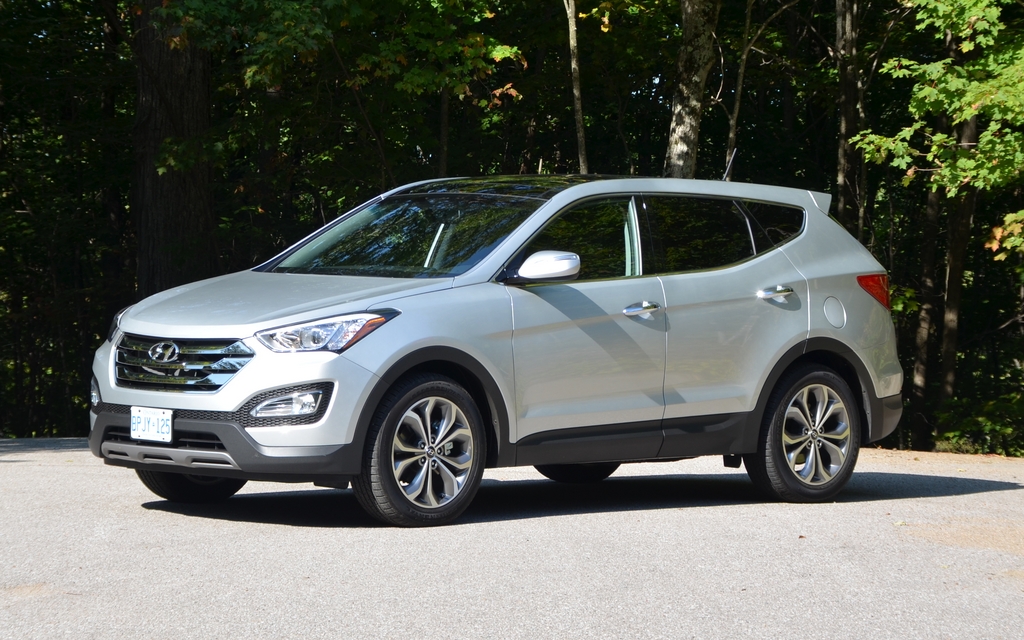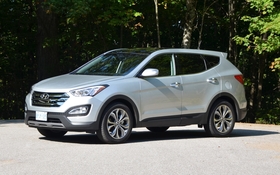2013 Hyundai Santa Fe Sport: Five seats or seven?

| Strong points |
|
|---|---|
| Weak points |
|
The Santa Fe, one of the best known names at Hyundai, was ripe for a third generation and Hyundai wants to take full advantage of the passion Canadians have for mid-size utility vehicles, a category that is constantly growing.
In fact, the new Santa Fe will be two vehicles. A few days ago, we drove the first version, the Santa Fe Sport, a five-seat crossover. The regular seven-seat Santa Fe will arrive at dealerships at the beginning of 2013.
Modern style
The Santa Fe Sport’s lines may not be revolutionary, but they’re decidedly modern and dynamic. Hyundai has named this style “fluidic sculpture”. The new Santa Fe is longer and lower than the one it’s replacing, changing the proportions by making it appear stockier and, consequently, more solid on the road.
The passenger compartment has also undergone a number of changes and features the style that has typified Hyundai since the makeover of the Tucson. It’s practical, nice looking, easy to operate and the materials are generally good quality, with the exception of the infamous leather steering wheel that’s just too slippery at Hyundai. The seats in Korean cars have never really agreed with my body, but in the case of the Santa Fe, I found them much more comfortable than I usually do. However, the cloth seats seemed cosier. In back, two-thirds of the seats are suitable while fans of the other third, located in the middle, will be few and far between.
The Santa Fe Sport’s dimensions (5 seats) put it in the same category as the Toyota Rav4, Venza and Ford Edge. The Santa Fe (7 seats), with its 100-mm longer wheelbase, will attempt to steal sales from the Honda Pilot, Kia Sorento and Chevrolet Traverse, as its predecessor the Veracruz did. But let’s get back to the Santa Fe Sport: it has a large passenger compartment and its trunk is very spacious, ranging from 1,002 litres with the rear seatbacks up to 2,025 when they’re lowered. That’s more than the Rav4, Venza and Ford Edge. Under the Santa Fe’s floor, there are practical storage bins.
Naturally-aspirated or turbo?
Mechanically speaking, the purpose of both engines is to move this new Hyundai. The first is a 2.4-litre four-cylinder with direct injection that develops 190 horses and 181 lbs-ft of torque. The only transmission offered is a six-speed automatic. It sends the torque to the front wheels or, for an extra $2,000, you can opt for all-wheel drive and its locking central differential to get it out of tricky situations where a Jeep Wrangler would pass with ease, even in two-wheel drive mode!
Unfortunately, during the presentation, I was only able to drive a Santa Fe Sport equipped with the 2.4-litre a few kilometres and in town only at that. Obviously, it doesn’t perform as well as the 2.0-litre turbo (we’ll talk about that in a moment), but it should be fine for people who don’t have to tow more than 907 kilos (2,000 pounds). During our city tour of approximately 25 km, we maintained an excellent average fuel consumption of 9.0 L/100 km.
The other engine is a four-cylinder as well, but it has a 2.0 litre capacity, features a turbocharger and produces 264 horsepower and 269 lbs-ft of torque. It doesn’t exactly give the Santa Fe wings, but it helps it go from 0-100 km/hr in less than 9.0 seconds.
Whether or not it’s in manual mode, the six-speed transmission attached to it isn’t particularly efficient. Moreover, regardless of the version, there are no paddle shifters behind the steering wheel. You can opt for front-wheel or all-wheel drive with the turbo as well. We recorded an average fuel consumption of 9.4 litres on our test drive, which is excellent, although I admit that I was taking it easy at the wheel. There’s also an Active Eco mode, but as it seems to eliminate a quarter of the horsepower, we decided to make the SPCA happy by saving these horses from almost certain death.
Steering that lacks bite
On the road, the Santa Fe, despite the Sport name, doesn’t offer a superior driving experience. Yes, it’s pleasant, but it’s not superior. The handling, for an SUV – sorry, I mean a crossover – is more than acceptable, it’s very comfortable and the quiet ride, if you ignore the wind noise coming from the front right window of several test vehicles, makes you want to go on a road trip.
The roll in turns isn’t excessive and the brakes do a respectable job in normal circumstances. An emergency braking situation didn’t convince us of their resistance with a trailer hitched to the vehicle. The power steering has three modes: Comfort, Normal and Sport, but Hyundai could have easily called them very loose, loose, and less loose. Note that it isn’t dramatic and that most people, once they find their preferred setting won’t change it. It also has a short turning circle.
Pricing for the Santa Fe Sport starts at $26,499 (2.4-litre, front-wheel drive) and climbs to $38,499 for the most luxurious version equipped with a turbocharged 2.0-litre and AWD.
The new Santa Fe Sport represents a clear evolution in the version that it’s replacing. Physically, it fits into the line-up wonderfully and, by being a little bigger than compact SUVs but still sold at a compact SUV price, it covers a broad section of this significant market. The regular Santa Fe will arrive to shoulder some of the load for the Santa Fe with the short wheelbase.











